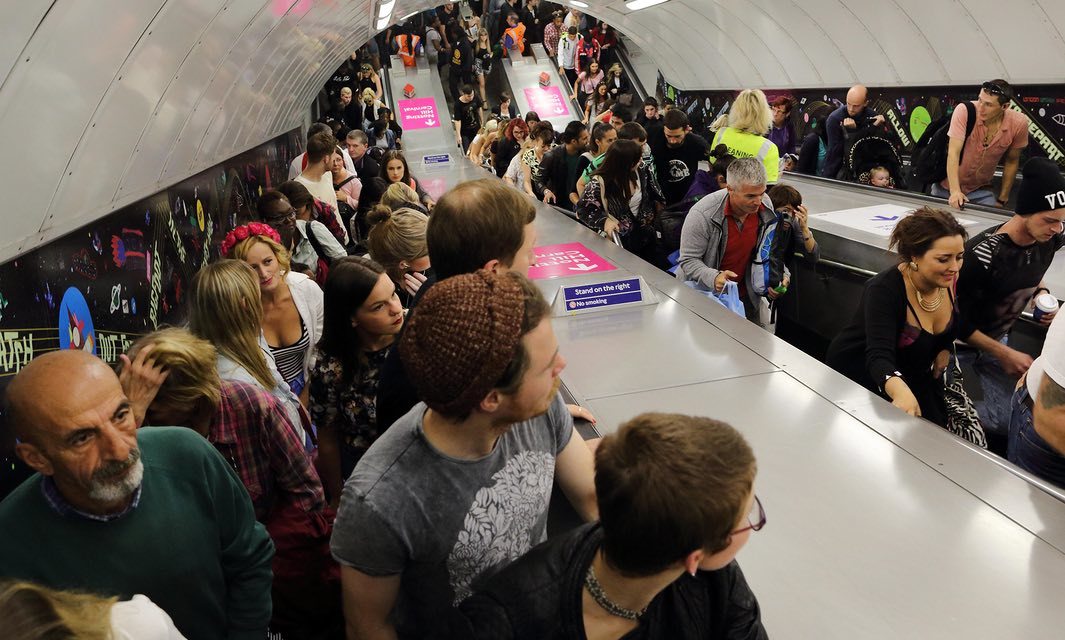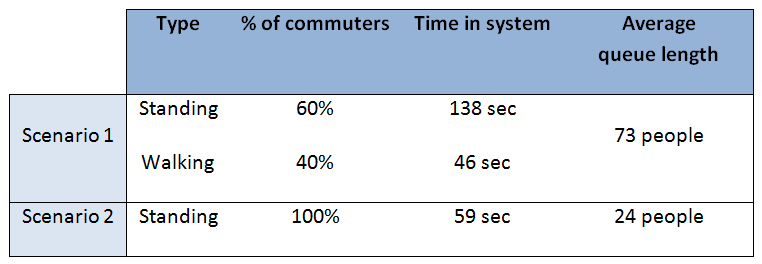If you stand on the subway escalator in two rows, its capacity increases by 31%

From 8:30 am to 9:30 am on Friday, angry passengers of the outermost escalator at the Holborn station of the London Underground were forced to stand in both rows
People who go along the escalator in the left lane save a few seconds. But experts have long figured out that this is far from the optimal loading of the escalator. Its capacity increases dramatically if all passengers stand in two rows.
According to a 2011 University Greenwich study , about 75% of passengers are on the escalator in the right lane, and 25% are on the left. Already from these figures the nonsense of such behavior is understandable. In the subway, Tokyo and Hong Kong have long understood this and for years have been teaching passengers to stand in two rows. Employees of the London Underground in 2016 conducted a six-month experiment on real passengers of one of the busiest Holborn stations, forcing them to change such harmful behavior, because of which there is a crush at the entrance to the escalator, slower transportation of people and deteriorating safety in the subway.
For the London Underground, the problem is very relevant. Opened in 1863, it has now grown to 270 stations and carries millions of passengers per day. On December 4, 2016, a record was set: 4,821,000 passengers in one day. The annual passenger traffic exceeds 1.3 billion people. In Europe, the London metro is second only to Moscow and Paris in terms of this indicator, so employees of the Moscow metro should take a closer look at this study of English colleagues.
')
The idea to change the usual behavior of the passengers of the meters came to one of the English experts after traveling to Hong Kong. There he noticed that all people quietly become on the escalator in the subway in two rows - and as if the passenger traffic seems to be more efficient. The specialist reported his observation to colleagues - and they decided to check it.
First, a computer simulation was created for the Green Park station (in open bases there are models of passenger traffic on different types of transport). She showed that climbing an escalator on foot takes 26 seconds, standing in the right lane - 40 seconds, and 40% of passengers prefer to walk in the left lane. At the same time, the left side skips a maximum of 70% of the passengers who stand on the right side, because each person on average takes two steps, and each walker takes four .
Then they launched a simulation of two different scenarios. In the first scenario, the “real situation” was described, when 60% are on the escalator and 40% are walking. And in the second scenario, both rows of the escalator were occupied by standing passengers. It turned out that in the first case the waiting and lifting time for standing and walking passengers takes 138 and 46 seconds, respectively. And in the second case - 59 seconds for all. That is, for 60% of passengers, the rise time is reduced by 79 seconds, and for 40% of passengers - increased by 13 seconds. The middle line in front of the escalator is reduced from 73 to 24 people.

That is, it turns out unequivocally that moving along the escalator while standing on both sides is beneficial - the average lifting time is significantly reduced. Those who used to go, lose only 13 seconds, but have a great service to the rest of the passengers, if they stand. The queue in front of the escalator is significantly reduced, which reduces crowding, improves safety, increases passenger comfort (no need to crowd in the queue) and increases the throughput of the escalator.
Holborn station in the London Underground in 2015 conducted a three-week experiment, and in 2016 - a six-month experiment , which confirmed the assumptions. During the experiment, one of the seven escalators was forcibly made two-row.

Comparison of single-row traffic at different stations showed that passengers in the right lane stand at every second step, and passengers in the left lane go through every fourth, because of which the space on the escalator is used irrationally.
At the same time on long escalators, as at Holborn station, a much smaller number of passengers prefer to go in the left lane. Here, the escalator has a length of 23 m 41 cm, so that very few people walk to the left, and some of them even stand, creating traffic jams.
Experts understand that a change in generally accepted rules will cause passenger discontent. Actually, the experiment at Holborn station has already confirmed this. People are accustomed to non-optimal behavior - to stand on the right and leave an empty lane on the left for those in a hurry. This is a tradition. Those who block the path to the left are sometimes even obstructed, made comments and ashamed. “Passengers just don’t like these things to change,” said Celia Harrison, an analyst on passenger traffic strategy at Transport for London and one of the key experts who promotes a “heretical” movement rate change on escalators. - I worked at the stations for many years. And I know that no matter what we do, people feel discomfort when we interfere with the standard routine. ”
The experiment at Holborn station fully confirmed the simulation results: the passenger traffic on the double-row escalator was significantly higher. At the time of the experiment, the escalator transported 16,220 passengers per hour instead of the standard 12,745. However, people perceived the officers who were driving the traffic with hostility. For the first three weeks, as soon as he was not called the experiment: "terrible", "crazy", "idiotic", "funny" and "very bad idea." 18 people called him "stupid." An employee who organized an escalator on Holborn said that one passenger even showed him the middle finger.
There's nothing to be done, people's habits are sometimes stronger than common sense. But the experience of Hong Kong and Tokyo shows that passengers can still be accustomed to the correct behavior, although it will take a long time to change habits.
Source: https://habr.com/ru/post/402963/
All Articles